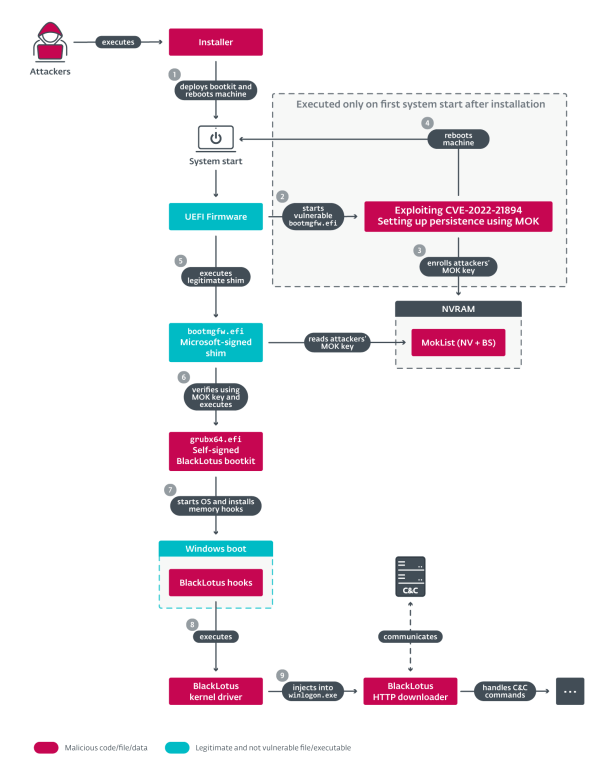ESET discovered a stealthy Unified Extensible Firmware Interface (UEFI) bootkit dubbed BlackLotus that is able to bypass the Secure Boot on Windows 11.
Researchers from ESET discovered a new stealthy Unified Extensible Firmware Interface (UEFI) bootkit, named BlackLotus, that is able to bypass Secure Boot on Windows 11.
Secure Boot is a security feature of the latest Unified Extensible Firmware Interface (UEFI) 2.3.1 designed to detect tampering with boot loaders, key operating system files, and unauthorized option ROMs by validating their digital signatures. “Detections are blocked from running before they can attack or infect the system specification.”
BlackLotus is the first UEFI bootkit that is able to bypass the security feature on fully up-to-date Windows 11 systems.
The BlackLotus malware is a UEFI bootkit that is available for sale on hacking forums since at least October 2022. The powerful malware is offered for sale at $5,000, with $200 payments per new updates.
Black Lotus is written in assembly and C and is only 80kb in size, the malicious code can be configured to avoid infecting systems in countries in the CIS region.
The malware supports anti-virtualization, anti-debugging, and code obfuscation. Black Lotus is able to disable security solutions, including Hypervisor-protected Code Integrity (HVCI), BitLocker, and Windows Defender. The rootkit is able to bypass security defenses like UAC and Secure Boot, it is able to load unsigned drivers used to perform a broad range of malicious activities.
The threat is very stealthy, it can achieve persistence at the UEFI level with Ring 0 agent protection.
Black Lotus supports a full set of backdoor capabilities, it could be also used to potentially target IT and OT environments.
Black Lotus is bringing APT capabilities to malicious actors in the threat landscape.
“Considering this tradecraft used to be relegated to APTs like the Russian GRU and APT 41 (China nexus), and considering prior criminal discoveries we’ve made (e.g. Trickbot‘s #Trickboot module), this represents a bit of a ‘leap’ forward, in terms of ease of use, scalability, accessibility and most importantly, the potential for much more impact in the forms of persistence, evasion and/or destruction.” wrote Scott Scheferman from firmware security firm Eclypsium.
ESET researchers reported that the bootkit exploits the vulnerability CVE-2022-21894 to bypass UEFI Secure Boot and maintain persistence. This is the first publicly known bootkit that abuses this vulnerability in the wild.
“Exploiting CVE-2022-21894 to bypass the Secure Boot feature and install the bootkit. This allows arbitrary code execution in early boot phases, where the platform is still owned by firmware and UEFI Boot Services functions are still available.” reads the analysis published by the experts. “This allows attackers to do many things that they should not be able to do on a machine with UEFI Secure Boot enabled without having physical access to it, such as modifying Boot-services-only NVRAM variables. And this is what attackers take advantage of to set up persistence for the bootkit in the next step. “
The experts pointed out that despite the issue was addressed by Microsoft in January 2022, its exploitation is still possible as the affected, validly signed binaries have still not been added to the UEFI revocation list.
Upon successful installation of the bootkit, the malicious code deploys a kernel driver and an HTTP downloader, used for C2 communication, which can load additional user-mode or kernel-mode payloads.
“Many critical vulnerabilities affecting security of UEFI systems have been discovered in the last few years. Unfortunately, due the complexity of the whole UEFI ecosystem and related supply-chain problems, many of these vulnerabilities have left many systems vulnerable even a long time after the vulnerabilities have been fixed – or at least after we were told they were fixed.”
“Many critical vulnerabilities affecting security of UEFI systems have been discovered in the last few years,” Smolár said. “Unfortunately, due the complexity of the whole UEFI ecosystem and related supply-chain problems, many of these vulnerabilities have left many systems vulnerable even a long time after the vulnerabilities have been fixed – or at least after we were told they were fixed.” concludes the report.
“It was just a matter of time before someone would take advantage of these failures and create a UEFI bootkit capable of operating on systems with UEFI Secure Boot enabled. As we suggested last year in our RSA presentation, all of this makes the move to the ESP more feasible for attackers and a possible way forward for UEFI threats – the existence of BlackLotus confirms this.”
Follow me on Twitter: @securityaffairs and Facebook and Mastodon
(SecurityAffairs – hacking, UEFI)
The post BlackLotus is the first bootkit bypassing UEFI Secure Boot on Windows 11 appeared first on Security Affairs.


